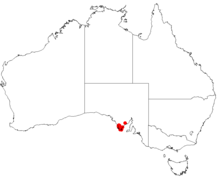Homoranthus homoranthoides
Homoranthus homoranthoides is a plant in the myrtle family Myrtaceae and is endemic to South Australia.
| Homoranthus homoranthoides | |
|---|---|
| Homoranthus homoranthoides in the Arboretum at the University of California, Santa Cruz | |
| Scientific classification | |
| Kingdom: | Plantae |
| Clade: | Tracheophytes |
| Clade: | Angiosperms |
| Clade: | Eudicots |
| Clade: | Rosids |
| Order: | Myrtales |
| Family: | Myrtaceae |
| Genus: | Homoranthus |
| Species: | H. homoranthoides |
| Binomial name | |
| Homoranthus homoranthoides | |
 | |
| Occurrence data from AVH | |
| Synonyms[1] | |
| |
Description
Homoranthus homoranthoides is a distinctive species recognised by its low growing prostrate habit. A shrub with greyish green linear leaves, small pendulous cream coloured flowers which turn red as they age.[2][3]
Taxonomy and naming
This species was first formally described in 1853 by Ferdinand von Mueller who gave it the name Schuermannia homoranthoides and published the description in the journal Linnaea.[4][5] In 1991, Lyndley Craven and S.R.Jones changed the name to Homoranthus homoranthoides.[6] The specific epithet (homoranthoides) refers to the similarity of this species (when named as Schuermannia homoranthoides) to those in the genus Homoranthus. The ending -oides is a Latin suffix meaning "like", "resembling" or "having the form of".[7]
Distribution and habitat
Homoranthus homoranthoides grows in heath and woodland on the southern part of the Eyre Peninsula. Grows on a variety of substrates in mallee heath and woodland.[8]
Conservation status
Moderately restricted distribution although well reserved and often locally common.[8]
References
- "Homoranthus homoranthoides". World Checklist of Selected Plant Families (WCSP). Royal Botanic Gardens, Kew.
- Craven, Lyndley A.; Jones, S. R. (1991). "A taxonomic review of Homoranthus and two new species of Darwinia (both Myrtaceae, Chamelaucieae)". Australian Systematic Botany. 4 (3): 513. doi:10.1071/SB9910513. Retrieved 19 August 2018.
- "Homoranthus homoranthoides". Goldfields Revegetation Plant Catalogue. Retrieved 24 August 2018.
- "Schuermannia homoranthoides". APNI. Retrieved 24 August 2018.
- von Mueller, Ferdinand (1853). "Diagnoses et descriptiones plantarum novarum, quas in Nova Hollandia". Linnaea: ein Journal für die Botanik in ihrem ganzen Umfange, oder Beiträge zur Pflanzenkunde. 25: 387. Retrieved 24 August 2018.
- "Homoranthus homoranthoides". APNI. Retrieved 24 August 2018.
- Brown, Roland Wilbur (1956). The Composition of Scientific Words. Washington, D.C.: Smithsonian Institution Press. p. 569.
- Copeland, Lachlan M.; Craven, Lyn A.; Bruhl, Jeremy J. (2011). "A taxonomic review of Homoranthus (Myrtaceae: Chamelaucieae)". Australian Systematic Botany. 24 (6): 351. doi:10.1071/SB11015.